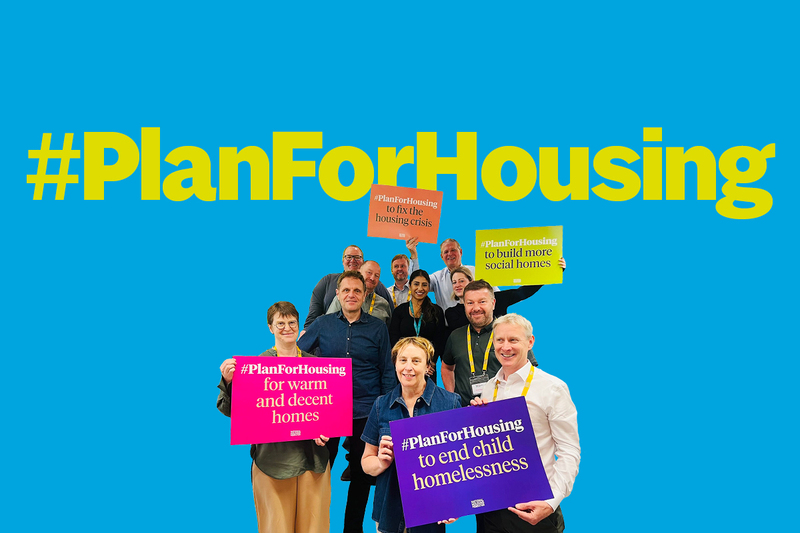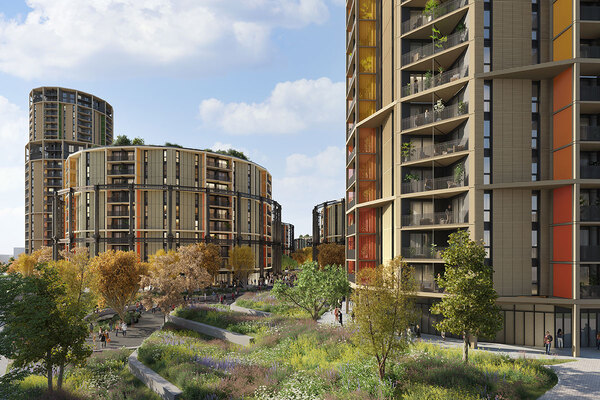Plan for Housing campaign: a big opportunity for an ambitious government housing strategy
Two weeks ago Inside Housing joined the National Housing Federation’s #PlanForHousing campaign. Its chief executive Kate Henderson tells Martin Hilditch why the next few months are critical to the future of housing in England. Photography by Peter Searle
The Plan for Housing must go down as one of the sector’s most successful campaigns ever. From early discussions involving just a handful of people a couple of years ago, calls for government to commit to developing a long-term housing strategy have gathered momentum. At times over the past year, LinkedIn felt like it had turned into a snow globe of images of senior figures from councils and housing associations holding up #PlanForHousing placards.
Following concerted lobbying both in front and behind the scenes, Labour’s manifesto pledged to develop a long-term plan. It has since reconfirmed that commitment, with the strategy expected to be published in the spring, possibly tying it in with the timings of the comprehensive Spending Review.
Job done? Not by a long chalk. The commitment to a strategy is there, but the content is, as yet, unknown. A team of civil servants are beavering away in the shiny halls of the Ministry of Housing, Communities and Local Government. And the sector now has just a few months to influence the process.
Why the campaign?
That is why, from this month, Inside Housing is partnering with the National Housing Federation (NHF) on the next phase of its Plan for Housing campaign.
Over the next couple of months, both the NHF and Inside Housing will be publishing a collection of thought leadership pieces from experts across the housing sector and beyond, to pull together policy suggestions that could help shape a comprehensive, long-term strategy (there is a piece from the Resolution Foundation to kick the series off here). A selection of essays will be collated and presented to MPs and key stakeholders at
a parliamentary event in January.
To set out the ambitions and reflect on the campaign so far, we are sitting down with Kate Henderson, chief executive of the NHF, on a Friday afternoon in the organisation’s headquarters in London’s Holborn. We also want to chat to Ms Henderson about what light the government’s recent Budget might shine on its direction and ambitions for the housing sector.
Let’s start at the beginning, though, and the genesis of the campaign.
“I think we started this by looking back to about 2010 and what has happened and where we were,” Ms Henderson says. “I think if you look back at that kind of period in social housing history, it isn’t a golden age. It’s an age that was dominated by cuts to the capital budget for affordable housing, which led to levels of new supply plummeting. Alongside that, there was no specific funding at that time for social rent, no funding at that time for regeneration.”
This, of course, was followed by a four-year government-enforced rent cut in 2015 that gutted capacity in the sector, a hokey cokey approach to planning reform and a cast of housing ministers who changed so quickly, some of them probably don’t even remember that they held the brief.
“We took a step back and said, ‘What is the outcome of all this?’” Ms Henderson recalls. “Well, the outcome is not enough social homes, not enough understanding of the value of social housing, not enough money to invest in our existing homes, or for regeneration. And when you look at the outcomes in society, they are dire.
The worst statistics I think are the ones looking at temporary accommodation, particularly children.”
To give that some context, the number of children living in temporary accommodation in England has soared in the past year alone from just over 130,000 to more than 150,000 today.
Reflecting on some of these terrible outcomes slowly led to the formation of the campaign we recognise today.
“The framing of why we need a long-term plan started with looking at what are the things that are not working and where would we like to go. So, rather than framing it as a kind of list of policies or target numbers, it was actually thinking, ‘Wouldn’t it be great if an outcome from a long-term plan in 10 years was that no child was homeless, or that we really tackled the levels of overcrowding, or we had a substantive change in the supply of new homes, so people had access to the stability of affordable housing?’”
You will notice that this selection of long-term outcomes generally has cross-party appeal, too. Across the political spectrum, there would be broad agreement that a desirable outcome of the housing system is not soaring numbers of children in temporary accommodation or wildly overcrowded homes.
As things stand, though, that is exactly what the system is belching out. And, frankly, while the average person in the street could probably take a wild stab at outlining the purpose of the health service or the education system, the absence of any kind of long-term vision for housing means it is much trickier to scrutinise its successes or failures, or plan beyond the immediate horizon.
After agreeing the broad aims of the campaign, the NHF then commissioned research looking at “what would happen if we didn’t have a change of direction”.
“It showed that on pretty much every metric, things were going to get worse,” Ms Henderson explains. Additional research into the economic value of social housing helped make the case that delivery “makes sense in terms of saving the taxpayer money over the long term”.
We all know what happened next. Making the case in private and in public saw the current government commit to creating a long-term strategy.
“That for us is a really exciting opportunity,” Ms Henderson states.
The spring timetable is hopefully a positive sign, she adds (although this comes with an important caveat).
“I think bringing forward a housing strategy in the spring means there’s an opportunity to align it with the Spending Review, and the Spending Review will obviously set out the government’s big commitments over the course of this parliament. So, it makes sense to have the strategy sit hand-in-glove with that.
“But what we are really keen to see with this long-term strategy is for it to be truly long-term. So, while it makes sense to align with the Spending Review, we would like to be thinking about 10 years minimum, but ideally longer – 20 to 30 years. Actually thinking about the future of housing in this country.”
This brings us almost to the present day and the opinion piece collection. But, actually, for any strategy to succeed there needs to be two other ingredients in place, Ms Henderson adds.
“I think what is really important is having vision and hope,” she says. “Hope is a funny word, but I think so many people are impacted by the housing crisis. At the very sharp end, we’re seeing record levels of rough sleeping, we’ve got the appalling, shocking figures of children in temporary accommodation. But there are also millions of people in overcrowded, unsuitable or unaffordable homes, and it feels hopeless.”
Vision and hope are two words we can all get behind. While that ultimate vision might need a bit more nuance, Ms Henderson says, a good starting ambition might be “that as a country, we should house our people well, that everybody should have a right to a decent, affordable, stable roof over their heads”.
This should be a housing strategy aimed squarely at the general public, she adds.
“There needs to be a housing strategy that speaks to the public that says, ‘This can get better, it will get better, and this is how we are going to do it,’” Ms Henderson says.
“The reason we want it framed in terms of outcomes is that that’s what people relate to. It isn’t an elitist housing policy agenda to say we want a housing strategy where an outcome is that no child is living in temporary accommodation. I think that is something that everyone can relate to, as is a strategy that addresses affordability, so we actually do have an offer for people on a low and moderate income.”
Cross-government work
With the opinion piece collection, the NHF is hoping to build “a really broad coalition of support” for a long-term strategy and for that process to be open and collaborative.
For that reason, Inside Housing was delighted to enter a partnership with the NHF in the hope of reaching as widely as possible for input.
“[The NHF’s] core membership is housing associations, but the case for good-quality social housing is much bigger than just us as a sector,” Ms Henderson says. “It’s really important that we have other voices shaping this agenda.”
This includes tenants and councils but also beyond the sector, too, as housing touches on so many areas – including health, education, the environment, welfare and energy. This means ministers and civil servants should “work across government” in creating the strategy, Ms Henderson believes.
This month’s thought piece from the Resolution Foundation is important not just to “work with thinktanks that are influential in the public debate but also in the policy debates that are not just housing – so, for example, investment with the Treasury”, Ms Henderson says. “Being able to have those kinds of voices will be really important in terms of making the case for a long-term strategy.”
Ultimately, the idea is “to present government with some consensus, hopefully, in January, but I think also with a real level of ambition and support for them to be bold and long-term in what they are striving for”.
Government ambition
If that is the long term, what do more immediate events have to say about the likely scale of the government’s ambition for the sector? We are speaking less than a fortnight after chancellor Rachel Reeves’
first Budget.
Among other things, that Budget topped up the Affordable Homes Programme to the tune of £500m, launched a consultation on a rolling five-year rent settlement (or possibly longer), reductions in Right to Buy discounts and the promised ability of social landlords to access building safety funding (although the detail on this is yet to be made clear – Ms Henderson says that “our view is access to building safety funding shouldn’t be based on who lives in the home, it should be based on risk”).
While the measures, by and large, were relatively short term, Ms Henderson thinks it was a significant moment. “We heard the chancellor in her first Budget prioritise the NHS, education and social housing. That is really significant to have a chancellor prioritising social housing.”
While the top-up to the Affordable Homes Programme did not give many indications about what will come next, Ms Henderson thinks that, overall, the Budget “is the first step in restoring confidence and stability into the social housing sector” (although she does stress that increases to employer National Insurance contributions could have a serious financial impact on associations providing care and support, and that a “proper, longer-term settlement for supported housing” is urgently needed).
In any number of ways, then, the next few months are crucial.
“I think we will be looking in the spring for a long-term housing strategy, but also for a really ambitious Spending Review that prioritises long-term investments in new supply but also our existing homes,” Ms Henderson adds.
“There’s a really big opportunity there to have a long-term, coherent, bold, ambitious package.”
Recent Plan for Housing articles
A long-term plan for housing – a once-in-a-generation opportunity
The new UK government has committed to creating a long-term housing strategy. Today, in partnership with Inside Housing, the National Housing Federation is launching a collection of opinion pieces designed to draw together views from across the housing sector and more widely to inform the strategy. Kate Henderson, chief executive, sets out the organisation’s initial thoughts on what should happen next
A long-term housing strategy could improve living standards across the country
As part of the National Housing Federation and Inside Housing’s #PlanForHousing campaign, Cara Pacitti and Lindsay Judge of the Resolution Foundation thinktank analyse the scale of the government’s challenge
It’s not job done when it comes to a long-term plan for housing: the next phase starts here
This week, Inside Housing announced it will be partnering with the National Housing Federation (NHF) on the next phase of its #PlanForHousing campaign. Editor Martin Hilditch sets out the next steps and why this is a crucial time to influence the government’s promised long-term housing strategy
Sign up for our daily newsletter
Already have an account? Click here to manage your newsletters















